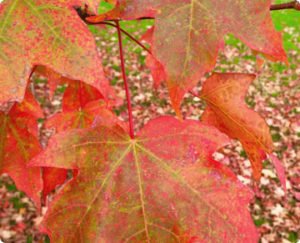The Science of Fall Foliage
How Seasonal Changes Impact Our Local Ecosystem
September 3, 2025
As September arrives in the Twin Cities, nature begins its most dramatic transformation. Trees along the Mississippi River blaze with color, parks in Minneapolis and St. Paul glow with golden canopies, and the air carries a crispness that signals the shift toward dormancy. But behind the beauty of fall foliage lies a fascinating story of biology, chemistry, and ecological balance.
Why Leaves Change Color
The vibrant reds, oranges, and yellows of autumn are more than just a seasonal spectacle; they’re the result of a complex process triggered by shorter days and cooler temperatures. During the growing season, chlorophyll, the pigment that gives leaves their green color, dominates. As daylight fades, chlorophyll production slows, revealing other pigments like yellow, orange, red, and purple.
In the Twin Cities, our climate plays a key role in the intensity of fall color. Warm, sunny days followed by cool, crisp nights create ideal conditions for anthocyanin production, leading to the brilliant reds we see in maples and sumacs. However, stressors like drought, disease, or pest activity can dull these colors or cause leaves to drop early, which may be an important signal that our trees are stressed.


A Time of Transition
Fall is not just a visual transformation; it’s a physiological one. Trees begin reallocating resources, sending sugars and nutrients down to their roots to prepare for winter. Lawns shift their energy below ground, strengthening root systems in response to cooler soil temperatures. Even insects respond to the seasonal cues, with many beginning their overwintering process in soil, bark crevices, or even inside our homes.
This period of transition is critical for the health of our urban and suburban landscapes. A well-timed rain can help trees and turf store moisture before the freeze. A sudden cold snap, on the other hand, can stress plants that haven’t fully hardened off. And as leaves fall and decompose, they return nutrients to the soil.

The Interconnected Ecosystem
What makes fall in Minnesota so special is how visibly interconnected everything becomes. The same leaf litter that nourishes soil also provides habitat for overwintering insects. The same cool nights that trigger color change also signal to rodents and pests that it’s time to seek shelter. And the same trees that dazzle us with color are quietly preparing for the long winter ahead.
Understanding these connections helps us make better decisions about how we care for our landscapes. Mulching leaves instead of bagging them can improve soil health. Monitoring trees for signs of stress now can prevent bigger problems in spring, and being proactive about sealing entry points around the home can reduce pest issues before they start.
A Season to Reflect and Prepare
Fall foliage is more than a fleeting display; it’s a reminder of nature’s resilience and rhythm. In the Twin Cities, where urban life meets natural beauty, this season invites us to slow down, observe, and participate in the care of our shared environment.
As you enjoy the changing colors along the Chain of Lakes or in your own backyard, take a moment to appreciate the science behind the scenes. Every leaf that turns and falls is part of a larger story, one that connects trees, turf, insects, and people in a cycle that repeats year after year.

Other items you may be interested in:

Five Reasons To Prune Your Trees This Winter
Pruning is a key part of keeping trees healthy and safe to live with in your Minnesota yard. It’s also one of the only landscape

Why Are My Leaves Yellow?
While you expect leaves to change colors in the fall, a tree with yellow leaves in the summer may indicate a health problem known as Chlorosis. Trees most commonly impacted by chlorosis include white oak, red maple, pin oak, river birch and white pine.

Fall Tips for Trees in the Twin Cities
Fall is the time when you prepare your yard for the cold winter months ahead.
